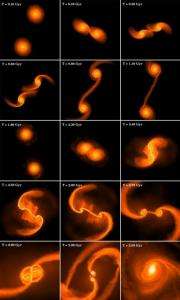First super-massive black holes were born 'soon' after Big Bang (w/ Video)

Astronomers believe they have discovered the origin of our universe's first super-massive black holes, which formed some 13 billion years ago.
The discovery fills in a missing chapter of our universe's early history, and could help write the next chapter -- in which scientists better understand how gravity and dark matter formed the universe as we know it.
In the journal Nature, Ohio State University astronomer Stelios Kazantzidis and colleagues describe computer simulations in which they modeled the evolution of galaxies and black holes during the first few billion years after the Big Bang.
Our universe is thought to be 14 billion years old. Other astronomers recently determined that big galaxies formed much earlier in the universe's history than previously thought -- within the first 1 billion years, Kazantzidis explained.
These new computer simulations show that the first-ever super-massive black holes were likely born when those early galaxies collided and merged together.
"Our results add a new milestone to the important realization of how structure forms in the universe," he said.
For more than two decades, the prevailing wisdom among astronomers has been that galaxies evolved hierarchically -- that is, gravity drew small bits of matter together first, and those small bits gradually came together to form larger structures.
Kazantzidis and his team turn that notion on its head.
"Together with these other discoveries, our result shows that big structures -- both galaxies and massive black holes -- build up quickly in the history of the universe," he said. "Amazingly, this is contrary to hierarchical structure formation."
The paradox is resolved once one realizes that dark matter grows hierarchically, but ordinary matter doesn't," he continued. "The normal matter that makes up visible galaxies and super-massive black holes collapses more efficiently, and this was true also when the universe was very young, giving rise to anti-hierarchical formation of galaxies and black holes."
For Kazantzidis and other astronomers, our Milky Way galaxy is small compared to others.
So when it comes to normal matter, big bits like giant galaxies and super-massive black holes come together quickly, and smaller bits like our own Milky Way galaxy -- and the comparatively small black hole at its center -- form more slowly. The galaxies that formed those first super-massive black holes are still around, Kazantzidis added.
"One of them is likely our neighbor in the Virgo Cluster, the elliptical galaxy M87," he said. "The galaxies we saw in our simulation would be the biggest galaxies known today, about 100 times the size of the Milky Way. M87 fits that description."
They started their simulations with two giant primordial galaxies -- ones made of the kinds of stars that were around at the beginning of the universe. Astronomers believe that back then, all stars would have been much more massive than present-day stars -- up to 300 times the mass of our sun.
Then the astronomers simulated the galaxies colliding and merging together.
The astronomers were able to make their discovery because they used supercomputers to provide a high-resolution view of what happened next.
Previous simulations showed details of the merged galaxy down to only about 300 light-years across. A light-year is the distance that light travels in year, about six trillion miles.
These new simulations contained features that were 100 times smaller, and revealed details in the heart of the merged galaxies on a scale of less than a light year.
The astronomers saw two things happen. First, gas and dust in the center of the galaxies condensed to form a tight nuclear disk. Then the disk became unstable, and the gas and dust contracted again, to form an even denser cloud that eventually spawned a super-massive black hole.
The implications for cosmology are far-reaching, Kazantzidis said.
"For example, the standard idea -- that a galaxy's properties and the mass of its central black hole are related because the two grow in parallel -- will have to be revised. In our model, the black hole grows much faster than the galaxy. So it could be that the black hole is not regulated at all by the growth of the galaxy. It could be that the galaxy is regulated by the growth of the black hole."
He and his cohorts also hope that their work will aid astronomers who are searching the skies for direct evidence of Einstein's theory of general relativity: gravitational waves.
According to general relativity, any ancient galaxy mergers would have created massive gravitational waves -- ripples in the space-time continuum -- the remnants of which should still be visible today.
New gravitational wave detectors, such as NASA's Laser Interferometer Space Antenna, were designed to detect these waves directly, and open a new window into astrophysical and physical phenomena that cannot be studied in other ways.
Scientists will need to know how super-massive black holes formed in the early universe and how they are distributed in space today in order interpret the results of those experiments. The new computer simulations should provide a clue.
Provided by The Ohio State University












.jpeg)







